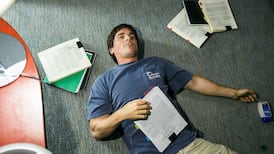Relish the scenes from the Taoiseach’s visit to Mayo.
Watch a woman leap into his body space and wield a phone camera inches from his face. See him get chased, jostled and pushed. Wince as a garda gets struck on the head, flinches and carries on. Goggle as members of the Burke family materialise like clamorous apparitions. Consider the implications as a small bunch of people manage to run the Taoiseach out of town while no one lays a restraining hand on them.
The pushing and jostling are dramatic enough but the phone cameras are the true pieces de resistance in such public fiascos. While the footage acquired rarely amounts to little more than snippets of discomfited or rictus-grinning faces, the true value of the phone camera is the licence it gives to the operator. It presents as non-threatening yet provides a pretext for bounding into a target’s space, to push in close, to walk straight up or to walk backwards in front of them slowing them down or stopping them, all moves which without a phone aloft could be interpreted as deranged, dangerous or hostile.
Ten years ago in Ireland the tactic was turbo-boosted by water-charges protesters, initially as a means of catching heavy-handed gardaí. Then it became a gotcha weapon. Five or six protesters, cameras aloft, would encircle a politician, garda or someone in the news, now physically slowed or stalled at the protesters’ pleasure, then batter him or her with “questions”. The sudden invasion of body space while being filmed by multiple cameras and pounded by a cacophony of angry voices can feel uncannily similar to an assault. If the target responds instinctively by swatting away an intrusive arm or phone, cue comically indignant bellows of pain and complaints about being assaulted, or having freedoms infringed.
READ MORE
It may have been Simon Harris’s supersonic walking speed – more like a sprint for most normal people trying to keep up – that kept him ahead of the posse in Mayo. The popular response to the videos seems divided: some despair at the protesters’ behaviour and the absence of firm security, others ask derisively why the brave Harris ran scared of stopping and engaging with an elderly man who only wanted answers about his incarcerated son.
The Taoiseach could have stopped and explained how the Taoiseach is constrained from purging another person’s contempt of court, adding that riots might ensue if he tried. But the Burkes already know that, given their intimate entanglements with the legal, justice and prison system as practitioners and clients.
Sean and Ammi Burke, father and (solicitor) daughter, were found guilty respectively last month of assaulting a woman garda in the Four Courts and of obstructing a garda who arrested another family member outside. Last January, while young Enoch was beamed in from Mountjoy Prison for his Court of Appeal hearing, four of the family were barred from the court due to what Judge John Edwards called their “track record” in disruptive court behaviour – shouting down the judge and physical removal being the least of it.
Short of an immediate, mandatory national reconversion to the precept that “all actions both of men and states must be referred” first and foremost to “our obligations to our Divine Lord, Jesus Christ” (yes, it’s still there in our venerated Constitution), who truly believes that any exchange would have placated them?
[ Garda investigation into Mayo incident where Taoiseach was ‘pushed and jostled’Opens in new window ]
The fact that the Taoiseach was accompanied by gardaí, security personnel and a sizeable retinue, yet forced to make a premature exit, exposes the limitless public forbearance some protesters now expect as a right. There is no evidence that the Burkes were involved in the physical pushing or jostling but their presumption that their obstructionist displays will continue to be indulged by the general public may have hit a wall. Even those who applaud their tenacity may draw the line when fundamental principles of our democracy are challenged.
One of these principles is that our political leaders should feel free to mingle safely with voters on Irish streets, unencumbered by the visual and physical insult (not to mention the cost) of large, dead-eyed security details. Ready access to politicians is one of those fundamental principles we take for granted, though now rarely seen in other countries. Any threat to that must be taken seriously.
None of this was invented by the Burkes or the Mayo protesters, of course. In 2014, when water meter installers, gardaí and politicians were being heavily targeted, one video showed protesters aggressively barracking a woman garda, with one telling her she would get “battered” if a male garda wasn’t standing beside her. Then tánaiste Joan Burton was videoed being hit on the head with a water balloon in Jobstown, attracting comments that – not for the first time – amounted to multiple incitements to hatred.
At the time, people on all sides of the water charges debate understood that the economic crash and bank bailout had created a vortex of public anger which saw water charges as the last straw. Creating martyrs out of activists is never a good move. But a rough beast was born and while some of those same leading actors may quibble about causes as similar tactics are turned on them now, the progression was inevitable. The intimidation and obsessive filming of ordinary workers and others then was a harbinger of what was to come.
The line between protest and harassment has become painfully blurred.
What the Mayo protests symbolised this weekend was a hideously engorged sense of entitlement.















